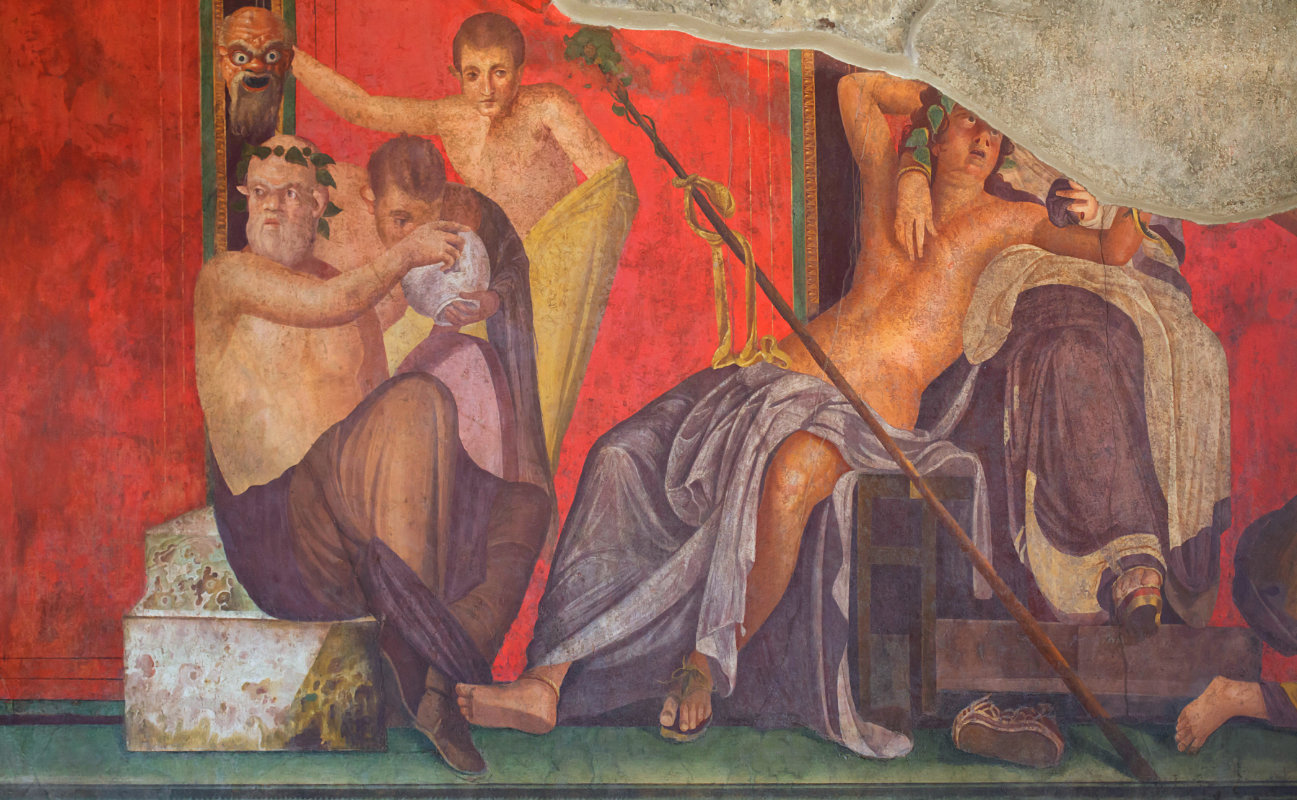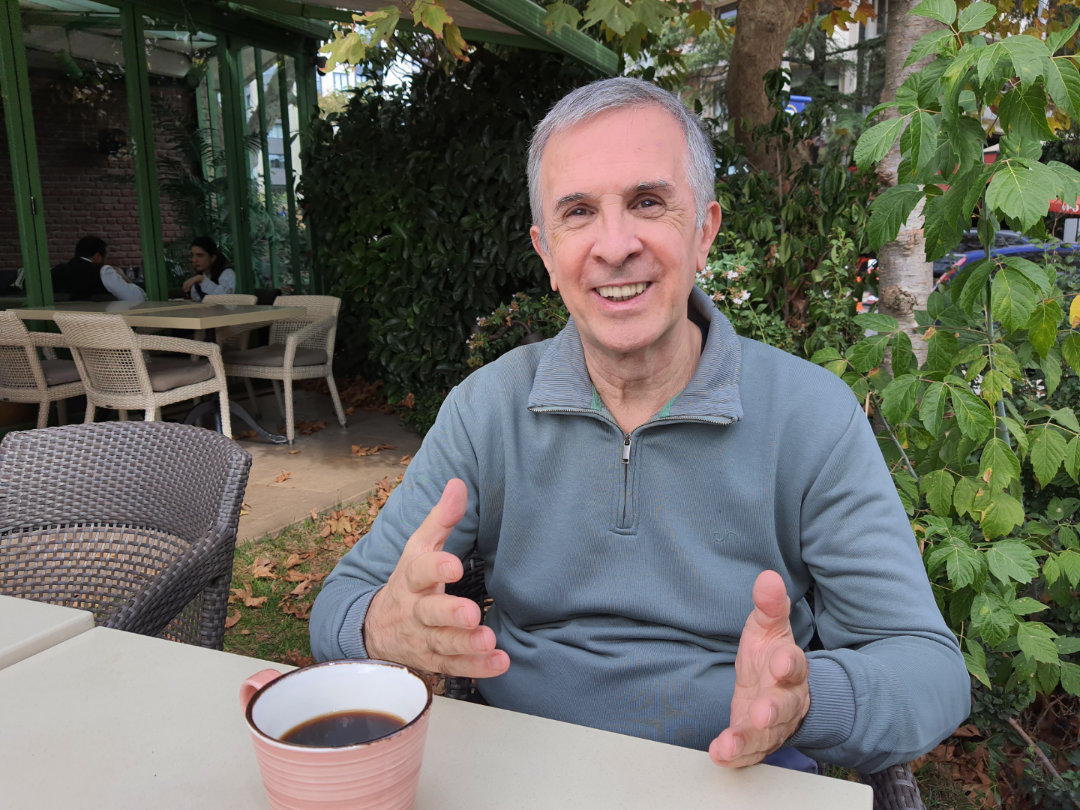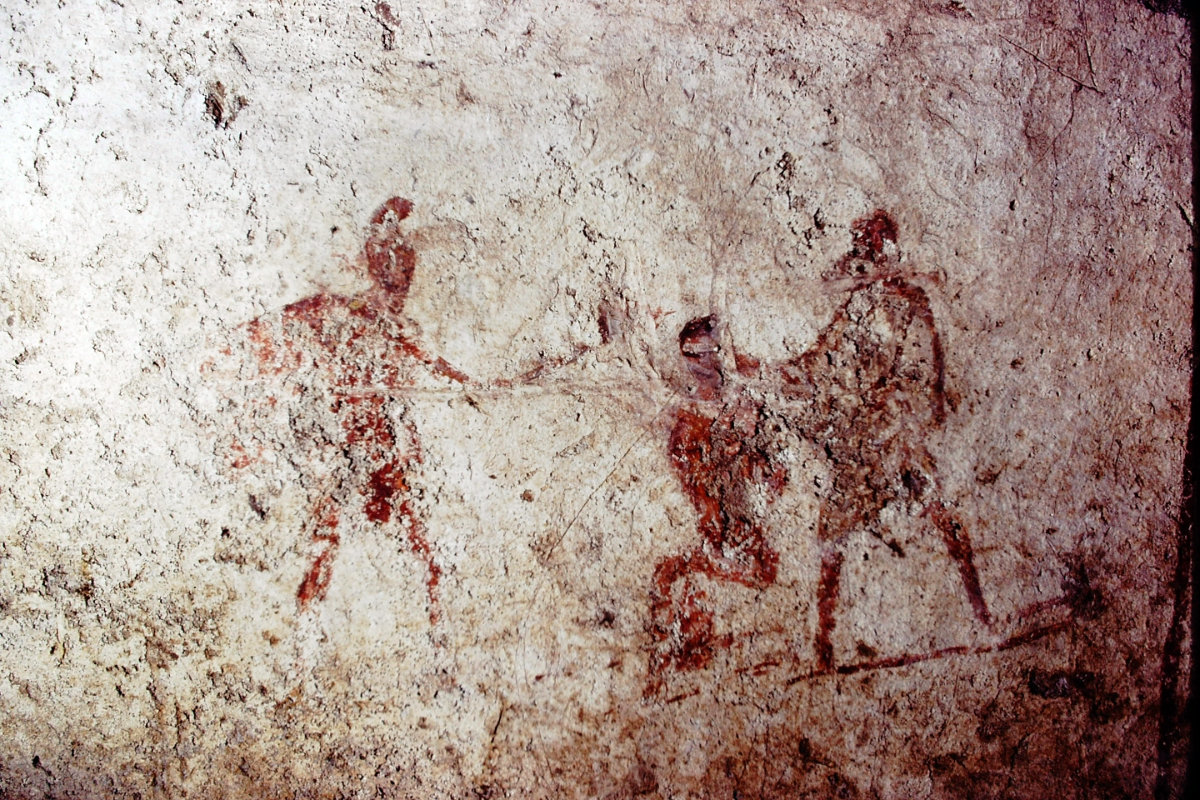Dancing out
the Mysteries of Dionysos

The Korybantic Scene and Dionysus lying on Persephone
Peter Mark Adams
Peter Mark Adams is an astonishing author both for his area of interest and for his ability to bring to light what many others have chosen to ignore or have been unable to find.
In his latest work, Mystai: Dancing out the Mysteries of Dionysos, Adams takes us back two thousand years through the fascinating frescoes of the Villa of the Mysteries at Pompeii.
Thanks to his kaleidoscopic knowledge of the ancient world and initiation rituals, Adams offers us unprecedented answers to a masterpiece considered by many to be the most important graphic testimony of the Western esoteric tradition.
The frescoes in the Villa of the Mysteries at Pompeii have been interpreted in many ways. Some say they are mere decorations, others propose a nuptial initiation. In your book, Mystai, published by Scarlet Imprint, you wonder why they remain so troubling. You literally write: ‘Given the formidable level of scholarship devoted to explaining its meaning over a century, the question naturally arises as to what makes this masterpiece so oblique, so problematic.’ Have you found an answer?
In a word: culture. Modern academic discipline rests upon the observation of strict disciplinary boundaries and a secular, materialist evidentiary regime. This tradition leaves the academy ill equipped to comprehend traditional polytheistic spiritual practices, of which the ‘rites of higher initiation’ or ‘mystery rites’ are paradigmatic, in anything other than sociological terms. It naturally leads to a deficit in the range of interpretive lenses deemed acceptable, in particular, interpretive schemes capable of accommodating the phenomenology of ritual participation.
The post-processual turn in both anthropology and archaeology, when combined with recent insights derived from cognitive science, has seen the emergence of a far more nuanced approach to interpretation. An additional factor, important in decoding the imagery of the Villa of the Mysteries, has been recent scholarship on female religious and spiritual leadership in antiquity; the lives, roles and responsibilities of priestesses and the codes by which they lived, including the codes governing dress and hairstyling. Without these developments it is almost impossible to contextualise and understand the Villa’s imagery in its elite Greco-Roman cultural setting.
In fact, I sometimes get the impression that some scholars are so concerned with methodology that they overlook certain essential questions in interpreting ancient mysteries that are, by nature, irrational or at the very least not subject to conventional logic. Have you encountered any resistance in relation to your explicit and straightforward interpretations of high Dionysian initiation?
Since I am situated outside of the academy and its institutional framework, there is no motivation for academics to engage professionally with my work, which has its audience in the wider world outside of the academy. The liberating aspect of this situation is that I can avail myself of a more transdisciplinary approach that, whilst acknowledging mainstream academic research, ranges beyond it to incorporate comparative ethnography, poststructuralist and phenomenological perspectives. I have found that this approach increases the ‘leverage’ that I have over the interpretation of this complex material.

Peter Mark Adams during our conversation
G. A. Adams
In the Dionysian Mysteries there are two main stages in initiation: purification, myesis, and the intitation itself, orgia or telete. Can you elaborate more on this? How did candidates or protomystai prepare themselves for initiation?
The preparatory ritual of myesis was designed to cleanse the candidate of ritual impurity or miasma and was a necessary prerequisite to taking part in an initiation into the mysteries of a deity. On a spiritual level the rite was thought to deflect the vengeful influence of the Erinyes or Furies, spirits who exacted vengeful retribution for past wrongdoing. So efficacious was this rite that it was often undertaken as a standalone ritual in its own right by those prone to inexplicable periods of ill-health, bad luck or other misfortunes. Indeed, the evidence suggests that the majority of people did just this with only a small minority going on to experience full initiation.
That said, the binary description — first myesis and then telete or orgia — somewhat over simplifies the actual sequence of purificatory and preparatory rituals that preceded initiation proper. In most cultures rites of higher initiation involve an entire regime of preparations involving such standard practices as taking oaths, renouncing certain behaviors, adopting a certain dietary regime, celibacy, isolation, contemplation, aspiration, bathing and prayer, and the making of offerings, reparations and pilgrimages.
We see this enacted in a formal context in relation to the rites of Eleusis were the group of people seeking initiation engaged as a group in bathing in the sea, making sacrifices and joining a day long civic and religious procession from Athens to Eleusis that was punctuated by prayers, offerings and sacrifices ending with an emotionally charged re-enactment of the core myth of the mystery deities, Demeter and Persephone. In parallel with these activities the priesthood would typically undertake their own extensive regime of preparations and purifications as well as purifying all of the ritual implements and the ritual space. So the breadth of activities engaged in in relation to initiation into the mysteries was far broader and more extensive than the formula myesis and then telete suggest.
What happened immediately afterwards? How does the initiation change those who undergo it?
Testimony concerning the positive effects of undergoing mystery initiation are extremely rare but what we do have derive from some extremely influential people including Cicero and members of his circle, Plutarch — himself a Delphic priest — and Apuleius, a major literary figure. The testimony describes the experience as one that improved the initiate’s outlook not only upon life but upon how they viewed their own deaths whilst extolling the rites as serving a fundamentally civilizing function.
The nocturnal, torch-lit ritual context of the main initiatory ritual was itself sufficient awe-inspiring to engender an overwhelming response. We are informed that for many, at least initially, the experience was a frightening one that even caused some people to panic as a flood of otherworldly entities within the deity’s entourage ‘swept through’ the ritual space preceding the ‘arrival’ of the deity and the influx of ‘energy’ that triggered states of ecstasy and bliss, and rendering the initiate confident of their own essentially spiritual and enduring higher nature. This is one example where the phenomenology of participation defies conventional academic interpretive strategies and therefore remains largely unexamined and ignored despite the fact that it lays at the very core of the efficacy accorded to the mysteries over the course of centuries and finds parallels in the ethnographies of contemporary ‘higher rites of initiation’.
You mention symbols that were recognised among the Dionysian community and perhaps openly acknowledged in the ancient world such as the colours purple and saffron or a gold ring with a red carnelian stone. Can you explain more about them? What other symbols have been identified?
We know that cult regulations for entry to the Hellenistic mysteries included stringent sumptuary laws that were enforced by the priesthood at the entrance to the sacred space. For women this involved not styling, binding or covering the hair, no jewellery and plain white clothing made from cloth priced beneath a certain level. Similar injunctions were applied to men. The objective of these regulations appears to have been social levelling, the elimination of any conspicuous display of wealth that would distract, and detract from, the sacredness of the rites.
The Villa of the Mysteries frescoes appear to depict four classes of women: a family of Greek lineage-holders — the two women and small boy —; the Roman women dressed as priestesses and outfitted in sumptuous purple and saffron robes with elaborate turbans and hairstyles; the rather plainly dressed initiate herself; and the assistants with uncovered hair. In other words, through variations in clothing — and, possibly, facial features — the artist was able to depict this elite performance as embedded within a distinct social hierarchy operating in contradistinction to the austerity and simplicity of traditional Hellenistic mystery rites.
The Greek lineage holders and the Roman priestesses all wear large gold rings inset with red carnelian stones. Such items, carved with the distinctive image or symbols of the deity, served to identify the bearer as an initiate of a particular ‘lodge’.
In the case of the Mithraic Mysteries our understanding is that the handshake was adopted as the name, syndexoi, by which Mithraic initiates referred to themselves and which served as a sign of recognition amongst initiates.

Fresco scene from the initiation ceremony at S. Capua Vetere.
University of Maryland / Stanley A. Jashemski (CC BY-NC 4.0)
In undertaking the Dionysian initiation, Bakkhic telete, the mystai were designated ‘those who have seen’ or epoptei. These appellations have sometimes been interpreted — I quote — ‘in terms of a hypothetical blindfolding of the mystai that was subsequently removed during the telete.’ However, there is no evidence of any such practice. Instead, in the Mysteries of Mithras, at least in one of the frescoes of Capua Vetere, we see a mystēs literally blindfolded. Can you explain more about the importance of sight in the mystic cults?
The stages of ritual participation and the applicable nomenclature in the Hellenistic mysteries has engendered considerable discussion over the years. The status of the initiates was marked by the use of two words: mystes and epoptes. After receiving the initial rite of purification, the myesis, the initiates were designated as mystes. The root of this word indicates the idea of something being ‘closed’ though whether it refers to the eyes or the mouth is left unclear. In fact this ambiguity is a fruitful one since not only were the initiates warned never to speak of their experience — the metaphor of the ‘closed mouth’ — they were also deemed at this stage to be, on a spiritual level, metaphorically ‘blind’ to the spiritual realities that initiation would open them to.
The contrasting term — employed at both Eleusis and Samothrace — was that of epoptes, literally ‘one who sees’. At Eleusis this referred to those who returned to repeat the mysteries the following year and may well have designated a similar status at Samothrace. The Mysteries of Eleusis were only performed once a year whereas the mysteries upon the island of Samothrace were open throughout the sailing season so that it is conceivable that a person could repeat the mysteries in the same year.
The one consistent report of the experience of mystery initiation is that of having seen the deity or deities at close hand. This bizarre reportage is supported by contemporary accounts of higher rites of initiation where detailed descriptions of having ‘seen’ the deity or deities are also reported.
Concerning physical blindfolding, in Eleusis the preliminary ritual of myesis appears to have involved an actual blindfolding. The myesis performed on Samothrace and in the Dionysian Mysteries, and possibly those of other deities such as Hekate, employed a different, korybantic, form of purification rite known as thronosis for which blindfolding is not attested. Blindfolding is not attested for the greater telete in any of these traditions.
In the case of Mithraism, however, the evidence from Capua Vetere suggests that actual blindfolding was integral to at least one of the multi-stage initiatory processes.
While Dionysian, Eluesian or Samothracian initiations seem to be single rituals in which the initiates experience death and rebirth, coming to see their gods themselves, the Mithraic initiation had seven phases. What other fundamental differences have you found between Mithraism and other ancient mysteries?
To address this question we need to recognise that there were at least three distinct systems of mystery initiation in operation across the Greco-Roman world: sanctuary based rites conducted by institutional priesthoods, lodge-based rites conducted by lineage-holding itinerant initiators, and lodge-based rites wherein the initiation was conducted by the lodge’s founding member.
The sanctuary based rites of Eleusis and Samothrace were defined by a permanent sanctuary and independent institutional establishment, hierarchical priesthood, initiatory lineages maintained within certain long-serving families, well-defined civic roles and responsibilities and a considerable overlap — administratively and in terms of religious festivals — between state and sanctuary. They also had a well-defined initiatory process whose main stages, various purifications, procession, rites and their timing, were an integral part of the civic calendar.
Lodge-based rites conducted by itinerant lineage-holding initiators appear to have formed a typical pattern for Dionysian initiation wherein the lodge or thiasoi — an association of the deity’s devotees — would organise the funding and hire a lineage-holder to perform the rites. Initiations were often performed during the yearly Dionysian festivals which also included competitive performances of poetry, dance and drama. In large towns and cities Dionysian priests, priestesses and ritual dancers could be hired through an association of Dionysian artists, the ‘Dionysian technitai’. In the countryside itinerant initiators would travel from village to village performing healing rites and initiations for a fee.
In contrast to both of these traditions the rites of Mithras, although evidenced empire wide, possessed no centralised organization or hierarchy. Despite this they nevertheless shared a common architecture, iconography and ritual process. In addition, they were privately funded local initiatives that only recruited small numbers of people, between 20 to 30 members, into a mithraic ‘lodge’. Recruitment was largely confined to members of the military and civil service. The diffusion of the cult throughout the empire appears to have occurred through the appointment and transfer of individuals or military units to different locales.
Apart from these structural differences the process of initiation into Mithraism appears to have recognised seven stages and to have utilised physical ordeals at least in the initial four stages. Initiations involving physical ordeals are more typical of the rites of entry into men’s societies, especially warrior societies, than into the Hellenistic mysteries — were such practices are not attested. The members of the Mithraic lodge also appear to have formed a united body who met together on a regular basis to engage in feasts and no doubt to discuss potential candidates and engage in the ritual processes. If solely viewed from this perspective we would be excused for thinking that the rites were simply those of entry into a warrior society. However, contemporary evidence points towards the probability that at some point in the initiatory process the initiate was ‘introduced’ to the deity and that this ritually mediated process was closer to the traditional pattern of the Hellenistic mysteries. In particular the depiction of Eros and Psyche in the Capua Vetere mithraeum demonstrates that within Mithraism we can discern an Orphic metaphysical undercurrent.
You explain that ‘contrary to the common literary association of Dionysos with the ecstatic maenadism of women, evidence suggests that Dionysian associations and their initiate members were predominantly male, and that perhaps only a third of the initiates were women.’ Can you tell more about gender and mystery cults?
In the Hellenistic world communities of devotees formed associations called thiasoi that acted somewhat like a ‘supporters club’ with their own rules and regulations. They served to organise their members for civic parades, festivities, banquets and even initiation rites. Thiasoi sought patronage and donations from local landowners and officials as well as gathering subscriptions from their members.
Within Dionysian thiasoi about a third of the devotees were women, and of all of the members only about a third undertook bacchic teletai, initiation into the mysteries of the deity. Independently we know that mystery rites to the deity took place during the deity’s festivals. Whereas the deity’s rural festivals appear to have involved a considerable amount of drinking — the thiasoi levied fines on any of its members who engaged in drunken fights —, masking, wild music, cross dressing, bawdiness and, no doubt, a certain level of indecency. We can contrast these rural festivities with the major city Dionysia that involved competitive performances of poetry, drama and dance and drew large audiences. Both of these festivities — rural and city —stood in marked contrast to the performance of the mystery rites. The instruments depicted in the frescoes of the Villa of the Mysteries are not suitable for wild music and indeed the entire performance of the mysteries appears to have been respectful and sedate in whatever tradition they were practiced.

Peter Mark Adams during our conversation
G. A. Adams
The reputation for wild, ecstatic maenadism has some basis in the rural Dionysia but its associations with violence derives entirely from Euripides play the Bacchae with which he won the city Dionysia dramatic competition in 405 BCE. Therein Euripides set a supernatural episode that describes the followers of Dionysus acting wildly and bloodily in retribution because the deity has been distained by the King, all of which makes for great drama but poor scholarship. You may recall that the penalties for revealing anything about the sacred mystery rites could be extreme, and therefore we can be sure that Euripides’ dramatic scenes are drama and nothing more. That said, and as we mentioned, the rural Dionysia — during which large amounts of wine were drunk — could become extremely rowdy.
Although some of the figures depicted in the frescoes are legendary beings, they all seem real people. Some have thick or pointed ears as a mark of their supernatural nature, but their expressions and even their theatrical postures make them all look like real persons playing a role. For example, in the Korybantic Scene, interpreted as the death of the boy Dionysus at the hands of the Titans, the artist could have depicted a Titan in a more conventional or at least impressive manner, but preferred to show an ordinary man holding a mask. The next scene, that of Dionysus lying on Persephone, the god seems so human, so individualised. He is the main god of the mysteries and strikes an archetypal pose, but seems as real as the biblical figures represented by prostitutes and brigands in Caravaggio’s paintings. Have you considered that, in addition to the female figures, men also participated in the high initiations of the Villa of the Mysteries? How do you interpret the stunning personification of the characters depicted in the frescoes?
The ritually-themed frescoes of the Villa of the Mysteries from the first century BCE exhibit an extraordinary depth of figuration and life-likeness. One that would not be seen again for another 1,500 years. We can find the same or similar figures, exhibiting the same or similar postures and activities, rendered in mosiac on a different continent — North Africa — three centuries later. We can therefore conclude that the artist did not invent the figures for this fresco sequence but derived them from a style book of Dionysian mystery figures. The figuration employed for depicting the secret mystery rites parallels — though with significant changes — that employed by artists for public frescoes and mosaics found throughout the empire.
All of the officiating figures in the fresco cycle are women. Almost all of the mythical figures, including those featured in the scene alluding to Dionysus Zagreus’ death at the hands of the Titans, depict male supernatural creatures. Despite, being situated in the most private rooms of a very large villa, the frescoes are nevertheless encoded to obscure the ritual processes depicted. There was a tradition of married women going aside to perform the Dionysian mystery rites during the major festivals and we therefore have no evidence to confirm or deny men’s officiation in the performance of these rites, though evidently men were initiated into the mysteries.
You, Robert Graves, Gordon Wasson or Carl A. P. Ruck among other authors favour the presence of psychoactive substances in the ancient mysteries. Even in ancient Christianity we constate the use of wine which, as you explain, was often mixed with other components and had to be cut with water to avoid intoxication. How widespread was the use of entheogens in the ancient world? What do we know besides the possible use of the ergot fungi in the Eleusinian Mysteries?
The mystery rites generally enforced a strict regime of secrecy. In the case of the rites of Eleusis secrecy was enforced under threat of capital punishment. The sanctuary’s priesthood were empowered to try and punish any violation of the sanctuary’s regulations. We can only assume that similar demands were made of initiates to other mystery rites. For this reason much of the speculation concerning the use and role of entheogens in the mysteries remains purely hypothetical.
One reason for the emergence of this speculation — certainly in the 1950s and 60s — was the experimentation of Western intellectuals with contemporary peyote cults in Mexico. The experiences induced by mescaline appeared to offer the possibility of solving the longstanding academic problem of accounting for the experiences of people who had undergone the mysteries in antiquity. Underpinning this idea is the materialist assumption that the experiences induced by mystery rites can not be accounted for other than by some form of chemical induction — in other words, by a material mechanism.
The idea that efficacious ritual practices were, of themselves, capable of inducing altered states of consciousness violated, and still does, commonsense assumptions and is therefore not considered to be serious, despite the fact that ethnographic field reports — spread over the course of almost a century — clearly indicate that just such shifts in awareness reported by professional anthropologists during the close observation of ritual practices in traditional societies do occur and give rise to bizarre visual images.
In relation to the use of entheogens in the Mysteries of Dionysus the frescoes of the Villa of the Mysteries clearly depict mushroom shapes incorporated into the furniture and the characteristic mythos of the deity contains elements that point towards there being a potential role for mushrooms within the initiatory process. The proposed means of its administration is also closely tied to the deity’s mythos and would ensure that it had the maximum, that’s to say, unfiltered and undiluted, impact. The mode of administering it was a common medical procedure during that pre-hyperdermic age, indeed it remains in use today.
What I am claiming for the Dionysian rites is that because they were performed by an itinerant initiator for a fee, the initiator needed to ensure that the client obtained a satisfactory result in the short time available to them. One way of quickly enhancing the intensity of any ritual process is to boost the energy state of the person to be initiated, and the most efficacious way of doing this is via a stimulant such as muscimol. In other words, I am suggesting that as a catalyst, the entheogen compliments, but is not essential to, the ritual process.
Mystai: Dancing out the Mysteries of Dionysos, by Peter Mark Adams, can be purchased from the official Scarlet Imprint website. The paperback version for USA customers is available on Amazon.

Comments
Add a comment